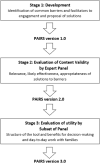Developing the Parent-Coaching Assessment, Individualization, and Response to Stressors (PAIRS) Tool for Behavior Analysts
- PMID: 35768672
- PMCID: PMC10465672
- DOI: 10.1007/s10803-022-05637-5
Developing the Parent-Coaching Assessment, Individualization, and Response to Stressors (PAIRS) Tool for Behavior Analysts
Abstract
Parent engagement in early behavioral intervention is essential to achieving meaningful intervention outcomes. However, parents may experience multiple barriers to engagement. The Parent-coaching Assessment, Individualization, and Response to Stressors (PAIRS) was developed to help practitioners assess families' barriers and facilitators, individualize their intervention, and respond to stressors using a contextual, functional approach. An expert panel of Board Certified Behavior Analysts ® (BCBAs) evaluated the content validity of the PAIRS. Average scale values (S-CVI/Ave) were 0.92 for relevance, 0.85 for effectiveness, and 0.91 for appropriateness. The PAIRS was revised, and a follow-up evaluation was conducted to rate the tool's utility. This led to the final version of the PAIRS. Clinical implications and future directions are discussed.
Keywords: Autism; Engagement; Family-mediated interventions; Parent training.
© 2022. The Author(s).
Conflict of interest statement
We wish to confirm that there are no known conflicts of interest associated with this publication and there has been no significant financial support for this work that could have influenced its outcome. No funds, grants, or other support was received. The authors have no relevant financial or non-financial interests to disclose.
Figures
Similar articles
-
Parent coaching intervention program based on the Early Start Denver Model for children with autism spectrum disorder: Feasibility and acceptability study.Res Dev Disabil. 2020 Oct;105:103747. doi: 10.1016/j.ridd.2020.103747. Epub 2020 Aug 4. Res Dev Disabil. 2020. PMID: 32763654
-
Parent coaching via telerehabilitation for young children with autism spectrum disorder (ASD): study protocol for a randomised controlled trial.Trials. 2023 Jul 19;24(1):462. doi: 10.1186/s13063-023-07488-6. Trials. 2023. PMID: 37468898 Free PMC article.
-
Parent coaching increases the parents' capacity for reflection and self-evaluation: results from a clinical trial in autism.Attach Hum Dev. 2018 Jun;20(3):287-308. doi: 10.1080/14616734.2018.1446737. Epub 2018 Mar 7. Attach Hum Dev. 2018. PMID: 29513132 Clinical Trial.
-
Remembering parents in parent-mediated early intervention: An approach to examining impact on parents and families.Autism. 2017 Jan;21(1):5-17. doi: 10.1177/1362361315622411. Epub 2016 Mar 7. Autism. 2017. PMID: 26951325 Review.
-
Systematic review of factors that may influence the outcomes and generalizability of parent-mediated interventions for young children with autism spectrum disorder.Autism Res. 2019 Sep;12(9):1304-1321. doi: 10.1002/aur.2168. Epub 2019 Jul 11. Autism Res. 2019. PMID: 31294532
Cited by
-
Implementation of coaching methods to decrease the parenting stress levels among teenage mothers in Indonesia: A quasi-experimental study.Belitung Nurs J. 2024 Apr 28;10(2):192-200. doi: 10.33546/bnj.3071. eCollection 2024. Belitung Nurs J. 2024. PMID: 38690301 Free PMC article.
-
How Can Qualitative Methods Be Applied to Behavior Analytic Research: A Discussion and Suggestions for Implementation.Behav Anal Pract. 2024 Feb 28;17(2):431-441. doi: 10.1007/s40617-024-00917-1. eCollection 2024 Jun. Behav Anal Pract. 2024. PMID: 38966259 Free PMC article. Review.
References
-
- Akamoglu Y, Meadan H. Parent-implemented language and communication interventions for children with developmental delays and disabilities: A scoping review. Review Journal of Autism and Developmental Disorders. 2018;5(3):294–309. doi: 10.1007/s40489-018-0140-x. - DOI
-
- Amsbary J, Able H, Schertz HH, Odom SL. Parents’ voices regarding using interventions for toddlers with Autism Spectrum Disorder. Journal of Early Intervention. 2020 doi: 10.1177/1053815120910744. - DOI
MeSH terms
LinkOut - more resources
Full Text Sources
Medical


